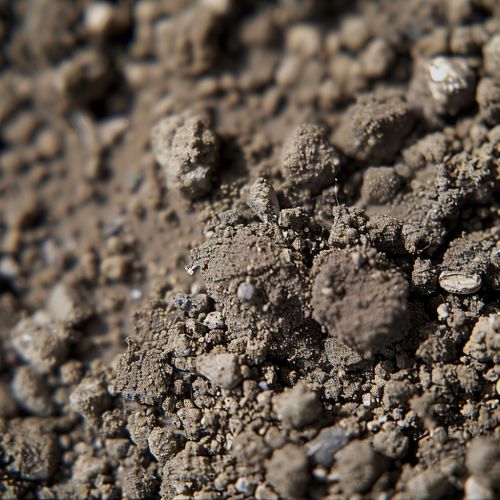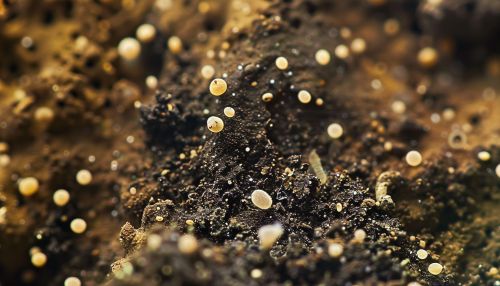Soil bacteria: Difference between revisions
(Created page with "== Introduction == Soil bacteria are a diverse group of microorganisms that play a crucial role in the ecosystem. These bacteria are found in the soil and are essential for various biological processes, including nutrient cycling, soil structure formation, and plant growth promotion. Soil bacteria can be classified into different groups based on their functions, morphology, and genetic characteristics. This article delves into the intricate world of soil bacteria, explo...") |
No edit summary |
||
| (One intermediate revision by the same user not shown) | |||
| Line 27: | Line 27: | ||
Some soil bacteria are pathogenic and can cause diseases in plants, animals, and humans. These bacteria can affect crop yield and quality. Notable examples include [[Agrobacterium tumefaciens]], which causes crown gall disease in plants, and [[Clostridium tetani]], the causative agent of tetanus. | Some soil bacteria are pathogenic and can cause diseases in plants, animals, and humans. These bacteria can affect crop yield and quality. Notable examples include [[Agrobacterium tumefaciens]], which causes crown gall disease in plants, and [[Clostridium tetani]], the causative agent of tetanus. | ||
[[Image:Detail-79833.jpg|thumb|center|Close-up of soil with visible bacteria colonies.|class=only_on_mobile]] | |||
[[Image:Detail-79834.jpg|thumb|center|Close-up of soil with visible bacteria colonies.|class=only_on_desktop]] | |||
== Functions of Soil Bacteria == | == Functions of Soil Bacteria == | ||
Latest revision as of 12:50, 20 May 2024
Introduction
Soil bacteria are a diverse group of microorganisms that play a crucial role in the ecosystem. These bacteria are found in the soil and are essential for various biological processes, including nutrient cycling, soil structure formation, and plant growth promotion. Soil bacteria can be classified into different groups based on their functions, morphology, and genetic characteristics. This article delves into the intricate world of soil bacteria, exploring their types, functions, interactions, and significance in the environment.
Types of Soil Bacteria
Soil bacteria can be broadly categorized into several types based on their functions and characteristics:
Nitrogen-fixing Bacteria
Nitrogen-fixing bacteria are capable of converting atmospheric nitrogen (N2) into ammonia (NH3), a form that plants can readily absorb. These bacteria can be free-living or form symbiotic relationships with plants. Notable examples include Rhizobium species, which form nodules on the roots of leguminous plants, and Azotobacter, a free-living nitrogen fixer.
Nitrifying Bacteria
Nitrifying bacteria are involved in the process of nitrification, where ammonia is converted into nitrites (NO2-) and then into nitrates (NO3-). This process is crucial for making nitrogen available to plants. Key genera include Nitrosomonas and Nitrobacter.
Denitrifying Bacteria
Denitrifying bacteria convert nitrates back into nitrogen gas (N2), completing the nitrogen cycle. This process occurs under anaerobic conditions and helps in maintaining the balance of nitrogen in the soil. Common denitrifying bacteria include species of Pseudomonas and Clostridium.
Decomposers
Decomposer bacteria break down organic matter, releasing nutrients back into the soil. They play a vital role in the decomposition of plant and animal residues. Examples include Bacillus and Actinobacteria.
Pathogenic Bacteria
Some soil bacteria are pathogenic and can cause diseases in plants, animals, and humans. These bacteria can affect crop yield and quality. Notable examples include Agrobacterium tumefaciens, which causes crown gall disease in plants, and Clostridium tetani, the causative agent of tetanus.


Functions of Soil Bacteria
Soil bacteria perform a wide range of functions that are essential for soil health and ecosystem stability:
Nutrient Cycling
Soil bacteria are integral to the cycling of nutrients such as nitrogen, phosphorus, and sulfur. They facilitate the transformation of these elements into forms that are accessible to plants. For instance, nitrogen-fixing bacteria convert atmospheric nitrogen into ammonia, while nitrifying bacteria convert ammonia into nitrates.
Soil Structure Formation
Bacteria contribute to the formation and stabilization of soil structure. They produce extracellular polymeric substances (EPS) that bind soil particles together, forming aggregates. This aggregation improves soil aeration, water retention, and root penetration.
Plant Growth Promotion
Certain soil bacteria, known as plant growth-promoting rhizobacteria (PGPR), enhance plant growth by various mechanisms. These include the production of phytohormones, solubilization of minerals, and suppression of plant pathogens. Bacillus and Pseudomonas species are well-known PGPR.
Bioremediation
Soil bacteria can degrade pollutants and contaminants, making them useful in bioremediation efforts. They can metabolize hydrocarbons, pesticides, and heavy metals, thereby detoxifying polluted soils. Pseudomonas putida is an example of a bacterium used in bioremediation.
Interactions with Other Soil Organisms
Soil bacteria interact with a variety of other soil organisms, including fungi, protozoa, nematodes, and plants. These interactions can be mutualistic, antagonistic, or neutral.
Bacteria-Fungi Interactions
Bacteria and fungi often interact in the soil, influencing each other's growth and activity. Mycorrhizal fungi form symbiotic relationships with plant roots, and bacteria can enhance this interaction by producing growth-promoting substances. Conversely, some bacteria can inhibit fungal growth through the production of antibiotics.
Bacteria-Protozoa Interactions
Protozoa feed on soil bacteria, regulating bacterial populations and nutrient cycling. This predation releases nutrients that are otherwise locked in bacterial cells, making them available to plants and other soil organisms.
Bacteria-Nematode Interactions
Nematodes can either feed on bacteria or be parasitized by them. Some bacteria, like Pasteuria penetrans, are parasitic to nematodes and can be used as biological control agents to manage nematode populations in agricultural soils.
Methods of Studying Soil Bacteria
The study of soil bacteria involves various techniques, ranging from traditional culturing methods to advanced molecular approaches:
Culturing Techniques
Traditional culturing techniques involve growing bacteria on nutrient media to isolate and identify different species. However, only a small fraction of soil bacteria can be cultured using these methods.
Molecular Techniques
Molecular techniques, such as polymerase chain reaction (PCR) and next-generation sequencing (NGS), have revolutionized the study of soil bacteria. These methods allow for the identification and characterization of bacteria based on their genetic material, providing a more comprehensive understanding of soil microbial diversity.
Metagenomics
Metagenomics involves the direct analysis of genetic material from soil samples, bypassing the need for culturing. This approach provides insights into the functional potential and diversity of soil bacterial communities.
Applications of Soil Bacteria
Soil bacteria have numerous applications in agriculture, environmental management, and biotechnology:
Agriculture
In agriculture, soil bacteria are used to enhance soil fertility and crop productivity. Biofertilizers containing nitrogen-fixing and phosphate-solubilizing bacteria are commonly used to improve nutrient availability to plants. Additionally, biopesticides derived from pathogenic bacteria are employed to control agricultural pests and diseases.
Environmental Management
Soil bacteria play a critical role in environmental management through bioremediation. They are used to clean up contaminated soils and water bodies by degrading pollutants and detoxifying hazardous substances.
Biotechnology
In biotechnology, soil bacteria are exploited for the production of enzymes, antibiotics, and other bioactive compounds. For example, Streptomyces species are known for their ability to produce a wide range of antibiotics.
Challenges and Future Directions
Despite the significant advancements in the study of soil bacteria, several challenges remain:
Cultivation Limitations
A major challenge is the inability to culture a large proportion of soil bacteria in the laboratory. This limitation hinders the comprehensive understanding of soil microbial diversity and function.
Environmental Variability
Soil bacterial communities are influenced by various environmental factors, such as soil type, pH, moisture, and temperature. Understanding how these factors affect bacterial diversity and activity is crucial for predicting their responses to environmental changes.
Climate Change
Climate change poses a significant threat to soil bacterial communities. Changes in temperature and precipitation patterns can alter soil conditions, impacting bacterial diversity and function. Research is needed to understand the resilience and adaptability of soil bacteria to climate change.
Future Research Directions
Future research should focus on developing novel culturing techniques to isolate previously unculturable bacteria. Additionally, integrating multi-omics approaches, such as metagenomics, metatranscriptomics, and metabolomics, can provide a holistic understanding of soil bacterial communities and their functions.
